
Constable sketch (detail) for View on the Stour.
Christie’s 250th anniversary – a summer of sensational sales and shows
By James Brewer
An epoch-making waterway painting from the early 19th century that inspired generations of artists will be the sales highlight of a celebration of the quarter-millennial anniversary of the London commercial art market.
Grand auction house Christie’s has chosen the last full-scale John Constable sketch in private hands as a signature work for its 250th anniversary sale Defining British Art.
The study was executed in about 1821 or 1822 for the finished canvas View on the River Stour near Dedham which was the fourth of six settings of the Suffolk working river which were exhibited at the Royal Academy between 1819 and 1825.
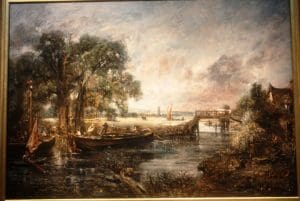
View on the Stour near Dedham. Full-scale sketch, oil on canvas. By John Constable.
‘Sketch’ it may be, but it sits comfortably among a wealth – in both senses – of art vaunted throughout the auction house’s huge King Street headquarters in St James’s, London.
It could go for between £12m and £16m in a glittering sale on June 30 2016 of British art from the past three centuries. Institutional buyers may pitch in with even higher bids.
Meanwhile in a new gallery at the same premises, Christie’s is putting on until July 15 a loan exhibition of British masterpieces that have passed through its salerooms over its many years. These will start with Portrait of King Henry VII from the circle of Hans Holbein II and range through Stubbs, Landseer, Turner, Burne-Jones, Rossetti, Lowry, Freud and Auerbach.
The Constable sketch is among masterpieces highlighted as of special interest by the firm’s super-auctioneer Jussi Pylkkänen – a man who has brought down the hammer on $3bn worth of lots in recent sales.

L’Ancienne rue de la Chaussée. Oil on canvas. By Claude Monet.
Constable (1776 – 1837) is categorised as a landscape painter, but he displayed in his output the intimate knowledge of river trading gained from his early years working in the flourishing family business trading and transporting corn and coal on the Stour.
He called his large-scale works six-footers, seeking to elevate depiction of the natural scenery he loved to a more ambitious scale – and to capture the attention of the high-ups of the Royal Academy. In the painting in question, the scene is upstream from Flatford Mill and Lock, and the details were followed closely in the final painting, unlike in three previous full-scale sketches.
Christie’s sold the sketch in 1883 for 1, 190 guineas, and it was acquired privately in 1995.

Mme Hanka Zborowska. Oil on canvas. By Modigliani.
Mr Pylkkänen, global president of Christie’s, characterised the invitation for offers for View on the Stour sketch as one of the business’s most important moments since the firm sold Constable’s The Lock at £22.4m in 2012, which made that one of the most expensive British paintings in history.
Christie’s says that the work to be sold on June 30 illustrates why Constable is considered the father of British modernism and acclaimed as an instinctive painter of nature and the elements. He revolutionised painting to a degree that gave rise to the French impressionists. His treatment of oil looks surprisingly contemporary: he made everything that had gone before look old-fashioned.
His legacy is abstract expressionism, turning illustration of landscape into a vehicle for the expression of human emotions.
Launching the summer events, Mr Pylkkänen recounted the origin of Christie’s, which is still a private company. Its founder, James Christie, who was born 1730 in Perth, Scotland, had spent a few years in the navy, and coming ashore was at a loss as to what to do next. He went to Covent Garden to work as an assistant to an auctioneer and in 1766 established his firm in Pall Mall, ante-dating such important institutions as the Royal Academy (which held its early exhibitions at Christie’s building) and Dulwich Picture Gallery.
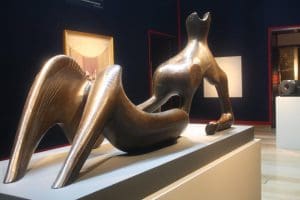
Reclining Figure, Festival. Bronze with a brown patina. By Henry Moore.
(The first sale catalogue printed by James Christie advertised “the genuine Household Furniture, Jewels, Plate, Fire-Arms, China &c And a large Quantity of Maderia [sic] and high Flavour’d Claret, Late the Property of A Noble Personage (deceas’d)… Which will be Sold by Auction By Mr Christie…)
Christie was selling very much to an English-based market and Reynolds and Gainsborough were among regular visitors to his saleroom. The British Empire was flourishing and the travels of aristocrats to France and Italy stimulated greater interest in art and antiquities. Further impetus came when the French nobility had to sell or surrender their collections under the pressure of revolution.
The firm moved from Pall Mall to King Street in 1823; the building had to be restored after bombing in 1941.

Pavonia. Oil on canvas. By Frederic Lord Leighton. c 1859.
Mr Pylkkänen emphasised that Christie’s has always championed British art and artists, and “if James Christie were alive today, he would represent the greatest artists who produce works of art in Britain.” In the temporary exhibition, “Why are we focusing on British art? Because we wanted to second-guess what James Christie would have selected.”
Christie’s now describes itself as “the world’s leading art business.” It says that its global auction, private and digital sales in 2015 totalled £4.8 billion ($7.4bn). The firm runs some 350 auctions annually in more than 80 categories, and has 54 offices in 32 countries and 12 salerooms including in London, New York, Paris, Geneva, Milan, Amsterdam, Dubai, Zürich, Hong Kong, Shanghai and Mumbai. It has expanded in what are seen as growth markets such as Russia, China, India and the United Arab Emirates.
“The art world is a global business, ” said Mr Pylkkänen. “In 2016 Christie’s is celebrating its10th year in Dubai and 30th in Hong Kong.”
The Constable will be offered for sale alongside masterpieces by Reynolds, Leighton, Lowry, Spencer, Bacon, Freud and others
Golden Hours, 1864, by Frederic, Lord Leighton (1830–1896) will be at auction for the first time in 100 years. A pivotal masterpiece of British aestheticism, it celebrates youth, beauty, and love, and the estimate is between £3m and £5m. In another gorgeous example, Pavonia, Leighton concentrates fully on the exotic beauty of his Mediterranean model Nanna Risi. The estimate here is between £1.5m and £2.55m.
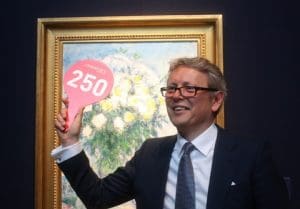
Jussi Pylkkänen.
An exquisite 1778 picture by Sir Joshua Reynolds, Portrait of Lucy Long, Mrs George Hastings, will be on the market for the first time, with an estimate of £2m to £3m.
The sculpture section of the sale will be led by Henry Moore’s 1951 Reclining Figure: Festival, commissioned by the Arts Council for the Festival of Britain in 1951, and the expansive structure is estimated to fetch between £15m and £20m. It was a focal point on the newly-built South Bank, symbolising the resilience of the British people after World War II. It was Moore’s first large reclining figure cast in bronze and, says Christie’s, “in many ways represents the pinnacle of Moore’s repeated exploration, since the late 1920s, of the reclining human form and his pioneering attempt to integrate this form with a sense of both landscape and space.”
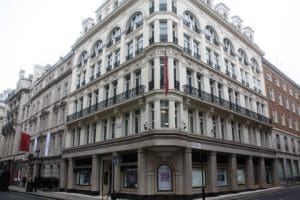
King Street headquarters of Christie’s.
Alongside this will be large-scale sculptures by Dame Barbara Hepworth, Sea Form (Atlantic), 1964 (estimate: £3m to £5m) and Lynn Chadwick, Back to Venice, 1988.
One of the most striking works in an Impressionist and Modern Art Evening Sale on June 22 will be the portrait Madame Hanka Zborowska by Amedeo Modigliani (1884-1920). He painted several portraits of Mme Zborowska, the wife of his dealer and supporter Leopold Zborowski, and this is an example of his mature style. The estimate is between £5m and £7m.
Modigliani is as popular as ever: in November 2015, at a sale conducted by Mr Pylkkänen in New York a Shanghai museum paid $170.4m with buyer’s premium for the Italian painter’s Nu Couché which was the second-highest price for a work sold at auction and far exceeded the estimate of $100m.
There will be great interest in Claude Monet’s L’ancienne Rue De La Chaussée. This plein air work with a rustic feel was painted ahead of the first Impressionist exhibition in 1874.The estimate is between £4.5m and £6.5m.

On loan. A Sofa in the form of Mae West’s Lips. By Salvador Dali and Edward
James.
On July 7, in an Old Master and British Paintings sale, a work by Sir Peter Paul Rubens which has not been seen for 150 to 180 years, Lot and his Daughters, will attract much attention. The oil on canvas completed in 1613 or 1614 passed through the possession of Antwerp merchants and royal hands including the Holy Roman Emperor Joseph I, and was at Blenheim Palace for 120 years until 1866.
The Rubens sale will be a focal point of what Christie’s London calls Classic Week from July 5 to 13 – with an eclectic range of subjects from antiquities to 19th century European art. The works will be on view and open to the public from July 3 at the company’s King Street and South Kensington offices.
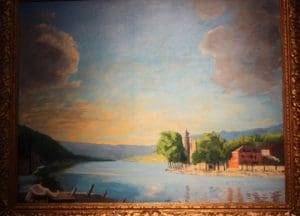
Scene on the River Meuse at Dinant. Oil on canvas, 1946-7. By Sir Winston Churchill.
How fares the art market against the wider financial background of tumbling equity values and weaker commodity prices? Mr Pylkkänen said: “Great works of art retain their qualities both in terms of the works themselves and their implicit value. A Monet will always be a Monet and a Picasso will be a Picasso.” He contrasted the “lasting value” of art works with investment in unstable financial markets and putting money into commodities.





